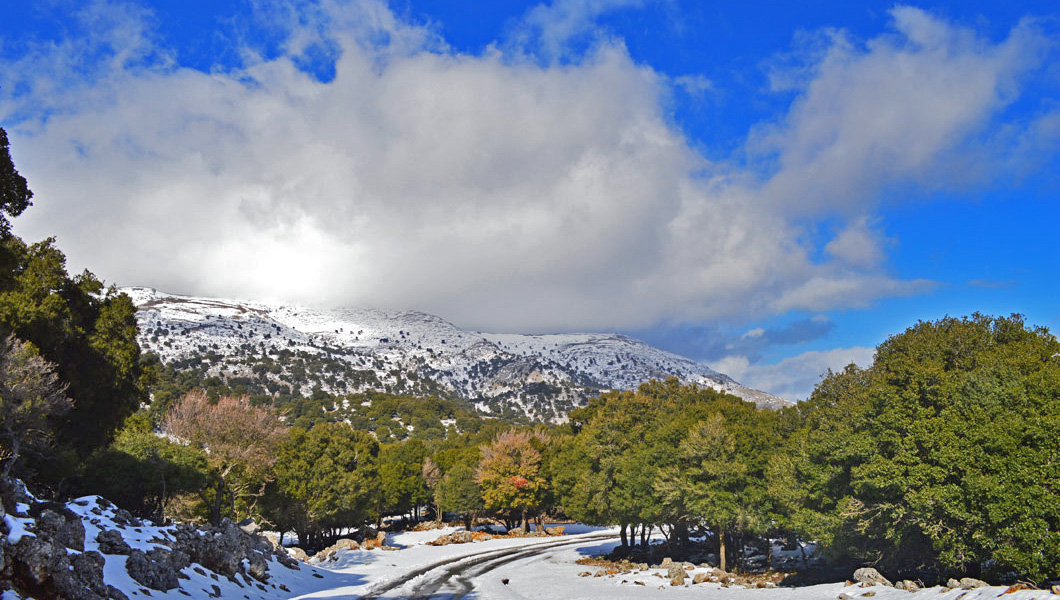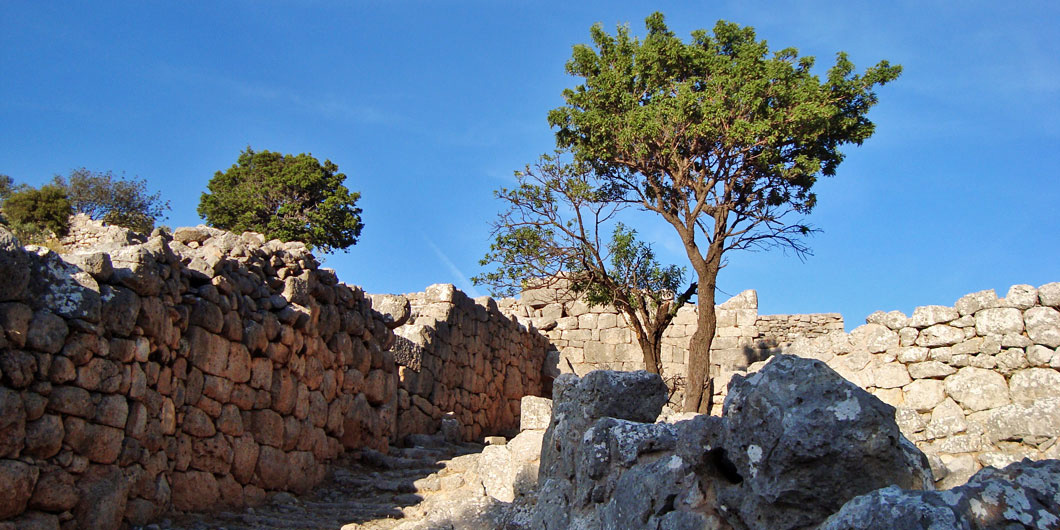This route, for the most part passes through a verdant landscape with an intricate geomorphology. It also passes through traditional villages, an extended pine forest and one of the most beautiful plateau of Crete. In addition, it offers many opportunities for hikes.
Aghios Nikolaos - Kalamafka - Males - Selakano
We set off from the picturesque town of Aghios Nikolaos (1), following the coastal road to Istron. From then on we continue south-westwards driving inland, and we make our first stop at the little village of Prina (2)

The route passes through a landscape with a complex geomorphology which is thick with olive trees. The town of Ierapetra and the sea appear ahead of us in the distance, a little before we reach Kalamafka.
With a clear sky, one may also be able to distinguish the island of Gaidouronssi (which is also known as Chrissi) on the horizon.
We can make a stop at Kalamafka and walk up to Kastélo, the precipitous rocky hill which stands high above the village, where there is a cave and a chapel of Timios Stavros. The view over the surrounding area from up there is magnificent. We can also visit the churches of Aghios Antonios and Aghios Ioannis or just enjoy a coffee under the shade of the plane trees in one of the cafenίa of the village.
Next, we leave Kalamafka and drive to the village of Males (3), where we can visit the Monastery of Panagia Exakousti. Then, we continue to Christos, and from there we take a road that goes uphill, leading to the forest of Selakano..
The little hamlet of Selakano (4) is sprinkled about in a sparsely forested area on the slopes of the valley of Selakano, which is surrounded by the stunning slopes of Mount Dikti. The settlement is mainly inhabited during the summer months, by farmers from the villages Christos and Males.
The Selakano basin area, with the extensive pine forest, is one of the most beautiful mountainous landscapes of Crete. It has been populated since antiquity; one can see traces of an ancient settlement, probably of ancient Malla, at the location of Patella.
If the cafenίo of the village happens to be open when you are there, you will have the opportunity to enjoy local dishes in the company of hospitable village folk.

From here, one can explore the forest of Selakano, which spreads as far as the slopes below Afendis Christos, the highest peak of Mount Dikti. This forest area, which is one of the most remarkable of Crete, is covered mainly with Calabrian pine (Pinus brutia), as well as deciduous oaks, maple trees, cypresses, plane trees etc, while many raptors find shelter in it. Selàkano is also considered a centre of beekeeping; numerous beekeepers from all over the island bring their bee hives to the location of Melissokipos (= bee garden).
In addition, there is an extended network of forest roads, and the E4 path passes through the forest. Therefore, the area is ideal for trekking, mountain biking and other outdoor activities.
We return to Selakano and take the dirt road which passes through the little settlement of Mathokotsana and then zigzags on the slope until it reaches another dirt road which goes northwards and leads to the plateau of Katharo (5),one of the most beautiful plateaux of the island. It should be noted though that this is a difficult dirt road which is not suitable for conventional vehicles.
You can carry on if you have a 4X4 off-road car, preferably after consulting with the local people, just to be sure. The condition of the road becomes worse in winter and spring, due to erosion caused by snow and rain.
If you manage to reach Katharo, make sure that from there on you continue on the asphalt road northwards and then eastwards, towards the traditional village of Kritsa. Once you are at Kritsa, you have the option to carry on to Aghios Nikolaos.
This is the reverse route of the section of the route which is described next.
Aghios Nikolaos - Kritsa - plateau of Katharo
This route can be taken as a one-day excursion. It links the touristic town of Aghios Nikolaos with picturesque Kritsa and ends at Katharo, which is considered one of the most beautiful plateaus of Crete. Alternatively, it can be followed after the previous route, from Selàkano to Katharo (or in the reverse order).

We take the road that leads to Kritsa (6), setting off from the intersection on the National road at Aghios Nikolaos. Driving in a northerly direction, we arrive at the amphitheatrically built traditional village of Kritsa, where we can visit Panagia Kera a church known for its exquisite Byzantine frescoes.
The film He Who Must Die, directed by Jules Dassin, with the late Greek actress Melίna Mercoúri in the leading role, was filmed in this village.
Here, one has the possibility to walk through the gorge of Kritsa which begins at the north-east exit of the village. The first, easy section of the gorge is 2,5 km long and it is full of plane trees, oaks and various endemic flora of Crete. This section together with the return to the village should not require more than 2 hours.
Three kilometers north of Kritsa one can visit the ruins of Lato an ancient town built on an impressive elevated naturally fortifiable site which dominates the scenery.

Lato was one of the most significant Doric city-states of Crete. Its territory extended from today’s Aghios Nikolaosto Katharo. Excavations have brought to light Lato’s fortifications, the Agora and a large part of the town.
We next take the road which passes through the village, and continue travelling uphill. The view over the gulf of Mirambello behind us is stunning. The scenery then becomes more and more rocky, with many large oaks, creating a wild yet beautiful setting, until we reach the plateau of Katharo (5).
Katharo is situated at an altitude of 1.100 metres. Little huts of stockbreeders, small vineyards and other cultivated areas can be seen around it.
Palaeolithic skeletons of dwarf hippopotamuses have been found it the area.
In Katharo, one can try traditional dishes at the tavernas which usually operate from spring to autumn and in some weekends during winter. After visiting ancient Lato, we carry on south of Kritsa and return to Aghios Nikolaos.























